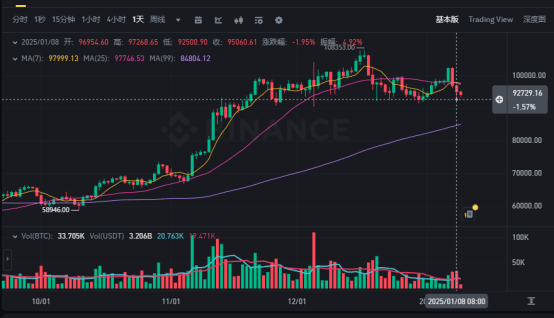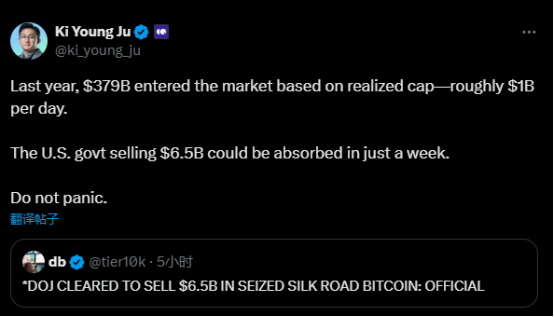Author: Luo Tuo Finance
The bells of 2025 have rung, but the market seems to have entered a "garbage time".
Even Bitcoin did not expect that $100,000 would become the standard for judging bull and bear markets. It was thought that Bitcoin reaching $100,000 on Monday would mark the beginning of the next upward trend, but unexpectedly, it only took two days for Bitcoin to start faltering. During the US trading session on Tuesday, the intraday low touched $92,600, a nearly 10% drop from the over $102,000 high on Monday. It is currently trading at $94,212.
While Bitcoin is watching from the sidelines, Altcoins have surrendered. ETH has retreated to $3,300, SOL is below $200, and the Altcoin sector has generally fallen by 10%, with institutional tokens like ADA, RNDR, and Aptos leading the decline. Even the US stock market has been affected, with leading mining stocks like TeraWulf, Bit Digital, Bitdeer, IREN, and Hut 8 falling 5-8%.
Although the decline is still manageable, the fact that Bitcoin's low is already close to its pre-year price, and the market sentiment has ebbed from its high, the news of the Silk Road sale has further dampened the market. There are even several analysts who believe that Bitcoin will drop to $70,000 before Trump's inauguration speech. For example, analyst Ali Martinez stated that BTC's critical support zone is currently between $97,041 and $93,806. He believes that if Bitcoin fails to meet this demand, it will plummet significantly to $70,085.
To see if this prediction comes true, we need to analyze the reasons behind this latest decline.
The market generally believes that the macroeconomic data released on Tuesday was the trigger for this drop. The US Bureau of Labor Statistics reported that the US JOLTS job openings in November exceeded 8 million, significantly exceeding expectations and setting a six-month high. This JOLTS data was mainly driven by growth in the business services industry, while demand for workers in other sectors was mixed.
The US JOLTS job openings in November were 8.098 million, exceeding the expected 7.74 million and the revised October figure of 7.8 million. The November job openings continued the rebound seen in October. In September, JOLTS job openings had unexpectedly plummeted to a new three-year low, sparking recession fears.
Released simultaneously with JOLTS was the US ISM Services PMI. The ISM Services Index recorded 54.1 in December, higher than the market expectation of 53.3 and the previous 52.1. This growth was mainly due to a significant increase in the services price paid sub-index, which jumped from 58.2 in November to 64.4, reaching the highest level since February 2023.
Overall, the macroeconomic data can be described as bright, but it is precisely this bright data that has led to the market's decline. The market generally believes that due to the strong macroeconomic support, the Federal Reserve is very likely to maintain a hawkish stance, and therefore needs to reprice the path to rate cuts. In other words, as the macroeconomic environment improves, there is no need to continue easing, but the impact on the liquidity of risky assets is inevitable. After the data release, traders no longer fully bet on the Fed cutting rates before July, and the S&P 500 and Nasdaq have fallen, in contrast to the soaring US 10-year Treasury yield and the US dollar index.
Coincidentally, the Federal Reserve released the minutes of the December 2024 Federal Open Market Committee (FOMC) policy meeting today, which were largely consistent with the previous month, clearly indicating that rate cuts will become more cautious. Committee members expect the pace of rate cuts in 2025 to slow significantly, with only about 75 basis points of cuts expected for the full year.
Macroeconomics is the key background, but the sensational statements from He Yi have also further fueled the market's risk-averse sentiment.
According to a report by CNN, four sources revealed that President-elect He Yi is considering declaring a "national economic emergency" to provide legal justification for imposing large tariffs on allies and competitors. The report states that after the US enters a "national economic emergency", He Yi will be allowed to use the International Emergency Economic Powers Act (IEEPA) to develop a new tariff plan, as IEEPA unilaterally authorizes the US President to manage imports during relevant national emergencies.
On January 7th, during a 70-minute press conference at his Mar-a-Lago estate in Florida, He Yi made frequent outrageous remarks, not only saying that he would "use economic means" to make Canada the 51st state of the US, not ruling out the use of force to seize the Panama Canal and Greenland, and promising to rename the Gulf of Mexico as the "American Bay". He also did not spare the Middle East issue, stressing that if Hamas does not release the Israeli hostages before he takes office, "the Middle East will descend into chaos". Such reckless rhetoric successfully provoked criticism from countries like Canada and Denmark after the press conference, and also made the market express concerns about the global economic outlook.
Due to the uncertainty of macroeconomic rate cuts and tariff impacts, the market's risk-averse sentiment has become prominent, with the three major US stock indexes fluctuating weakly, the US dollar index rising sharply, and non-US currencies plummeting. The cryptocurrency market, naturally, has not been spared. ETFs representing institutional capital have also reflected this point - on January 8th, the US Bitcoin spot ETF had a net outflow of $583 million, and the Ethereum spot ETF had a net outflow of $159 million, indicating an outflow of funds.
Another unfortunate event is that this morning, DB News reported that according to an official, the US Department of Justice has been authorized to liquidate the 69,370 BTCs seized in the Silk Road case, worth about $6.5 billion. The rumor is not unfounded - as early as December 3rd, the US government had transferred 19,800 bitcoins related to Silk Road, worth nearly $2 billion, to Coinbase Prime, which the market had interpreted as the government's preparation for a sale. The expectation of increased selling pressure has exacerbated market panic, with BTC briefly dropping over 1% and touching below $94,000 again.
Although the panic has not subsided, from the current stage, there are still less than 10 days before He Yi's formal inauguration and speech, and February is also the earnings season, so the market outlook is still relatively more positive than negative. From the news perspective, there are still supportive positive information.
2025 trading themes and key nodes, image source: CICC
First, there is a turning point in the lawsuit between Coinbase and the SEC. The US District Court for the Southern District of New York has approved Coinbase's motion for an interlocutory appeal, allowing it to appeal the SEC's allegations to the Second Circuit Court of Appeals, with the case temporarily suspended in the meantime. The reason is that the judge believes there are differences in the legality of cryptocurrencies across different federal courts, and therefore the legal status needs to be definitively determined. If the Second Circuit agrees to hear the case, the federal government will have the opportunity to resolve the SEC's legal authority over digital assets, a critical legal issue. It is worth noting that since this is an appeal in the middle of the litigation, the possibility of the case being dismissed will be greatly increased, putting the SEC in a very passive position. If the appeal is successful, the SEC's issue with Coinbase's listed coins being securities may also be resolved, paving the way for Altcoin ETFs.
Second, the CFTC chairman, who had previously vied to become the top crypto regulator, has resigned, but in his last public speech, he still expressed a positive sentiment towards crypto regulation. The Trump team has already begun to look for a crypto-friendly successor, with current CFTC Commissioner Summer Mersinger, a16z's crypto policy head and former CFTC Commissioner Brian Quintenz, and Kraken's Chief Legal Officer Marco Santori all under consideration. It can be seen that the Trump team has a high degree of consensus on deregulating the crypto industry.
In this context, the whales have a rather positive attitude towards the future trend of Bitcoin, with dip-buying and bottom-fishing becoming their common operations.
Data compiled by @Phyrex_Ni shows that the panic sentiment is evident among small holders, with a clear trend of reduction in holdings among investors with less than 10 BTC during the recent price decline, and exchange holdings also continuously declining, but large holders are relatively confident, with investors holding more than 10 BTC showing a clear trend of increasing their holdings.
Cauê Oliveira, research director at Blocktrends, confirmed this data, stating that at the end of 2024, institutional investors sold a large amount of Bitcoin, but are now starting to buy back at prices below $100,000. In the week following December 21, wallets holding 1,000 to 10,000 BTC sold 79,000 BTC, but this group has recently been accumulating Bitcoin at prices below $95,000.
As for the Silk Road, which has caused panic, the impact may not be as great as expected. First, Trump had publicly promised that the US government would not sell any Bitcoin after his election, which was a slap in the face and may be reversed later. Even if confirmed that it can be sold, it would not happen overnight, and may require a months-long approval process. Secondly, to maximize profits, large-scale sales are usually conducted through over-the-counter acquisitions, which can also control the impact on prices. Furthermore, even if it is a one-time market entry, given the current liquidity, it would only take a little over a week to be absorbed, without causing panic. CryptoQuant CEO Ki Young Ju stated that "based on realized market capitalization, there was $379 billion inflow to the market last year, about $1 billion in daily liquidity. The $6.5 billion (Bitcoin) sold by the US government may be absorbed within a week."
Therefore, some institutions are very optimistic, believing that the decline caused by selling pressure is a buying opportunity. BitMEX co-founder Arthur Hayes wrote about the Silk Road's entry into the market, saying, "Diamond hands are ready to buy the dips."
Overall, although the sentiment has declined and there is indeed panic, with the support of institutions and whales buying the dips, even if the crypto market declines, it is highly unlikely to see a collapse. The current Bitcoin accumulation zone is still around $95,000, and the price is mostly hovering around this level, with a large decline possibly returning to below $90,000, but the probability of reaching $70,000-$80,000 is relatively low.
In addition to the continued focus on Trump's policies, the next important market observation event is the release of the US December non-farm payroll report on Friday night. Although the ADP "small non-farm" data on Wednesday was lower than expected, giving the market a slight relief, the non-farm data often differs significantly from ADP, and non-farm data is one of the key factors in the Fed's policy decisions, so it is the focus of the market. Weaker-than-expected job market data may cause the Fed to turn dovish again.
Currently, the market generally expects that the US December non-farm payroll employment will slow to 153,000 and the unemployment rate will remain at 4.2%.
















